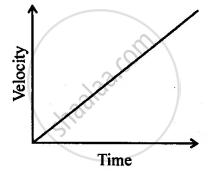Advertisements
Advertisements
प्रश्न
An object starting from rest travels 20 m in the first 2 s and 160 m in the next 4 s. What will be the velocity after 7 s from the start?
उत्तर
For first 2 s motion of object,
u = 0, f = 2 s, s = 20 m
Using s = `"ut" + 1/2 "at"^2`
we got 20 = `0 + 1/2 "a" xx 2^2`
or a = 10 ms−2
Velocity attained by object at the end of 2s
v = u + at
= 0 + 10 × 2
= 20 ms−1
For next 4s, journey of object,
t' = 4s, u' = 20 ms−1, s' = 160 m
∴ s' = `"u'""t'" + 1/2 "a'""t'"^2`
⇒ 160 = `20 xx 4 + 1/2 xx "a'" xx 4^2`
or 8a' = 80 or a' = 10 ms−2
It implies that acceleration is uniform throughout the journey.
∴ velocity after 7s from start, v = u + at
= 0 + 10 × 7
= 70 ms−1
APPEARS IN
संबंधित प्रश्न
When will you say a body is at non-uniform acceleration?
Fill in the following blank with suitable word :
Velocity is the rate of change of……………………… It is measured in.............. .
A train starting from stationary position and moving with uniform acceleration attains a speed of 36 km per hour in 10 minutes. Find its acceleration.
A car acquire a velocity of 72 km per hour in 10 second starting from rest. Find
(1) the acceleration,
(2) the average velocity, and
(3) the distance travelled in this time.
Define velocity. State its unit.
A bicycle initially moving with a velocity 5.0 m s-1 accelerates for 5 s at a rate of 2 m s-2. What will be its final velocity?
A body, initially at rest, starts moving with a constant acceleration 2 m s-2. Calculate: (i) the velocity acquired and (ii) the distance travelled in 5 s.
When is the positive acceleration?
When is the negative acceleration?
Can you suggest a real-life example about the motion of a body from the following velocity – time graph?

